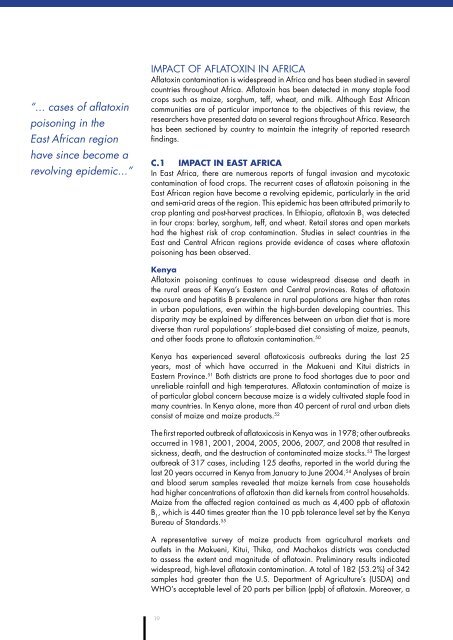Aflatoxin: A Synthesis of the Research in Health, Agriculture and Trade
Aflatoxin: A Synthesis of the Research in Health, Agriculture and Trade
Aflatoxin: A Synthesis of the Research in Health, Agriculture and Trade
Create successful ePaper yourself
Turn your PDF publications into a flip-book with our unique Google optimized e-Paper software.
“... cases <strong>of</strong> aflatox<strong>in</strong><br />
poison<strong>in</strong>g <strong>in</strong> <strong>the</strong><br />
East African region<br />
have s<strong>in</strong>ce become a<br />
revolv<strong>in</strong>g epidemic...”<br />
iMPAct <strong>of</strong> AflAtox<strong>in</strong> <strong>in</strong> AfRicA<br />
<strong>Aflatox<strong>in</strong></strong> contam<strong>in</strong>ation is widespread <strong>in</strong> Africa <strong>and</strong> has been studied <strong>in</strong> several<br />
countries throughout Africa. <strong>Aflatox<strong>in</strong></strong> has been detected <strong>in</strong> many staple food<br />
crops such as maize, sorghum, teff, wheat, <strong>and</strong> milk. Although east African<br />
communities are <strong>of</strong> particular importance to <strong>the</strong> objectives <strong>of</strong> this review, <strong>the</strong><br />
researchers have presented data on several regions throughout Africa. <strong>Research</strong><br />
has been sectioned by country to ma<strong>in</strong>ta<strong>in</strong> <strong>the</strong> <strong>in</strong>tegrity <strong>of</strong> reported research<br />
f<strong>in</strong>d<strong>in</strong>gs.<br />
c.1 iMPAct <strong>in</strong> eASt AfricA<br />
<strong>in</strong> east Africa, <strong>the</strong>re are numerous reports <strong>of</strong> fungal <strong>in</strong>vasion <strong>and</strong> mycotoxic<br />
contam<strong>in</strong>ation <strong>of</strong> food crops. <strong>the</strong> recurrent cases <strong>of</strong> aflatox<strong>in</strong> poison<strong>in</strong>g <strong>in</strong> <strong>the</strong><br />
east African region have become a revolv<strong>in</strong>g epidemic, particularly <strong>in</strong> <strong>the</strong> arid<br />
<strong>and</strong> semi-arid areas <strong>of</strong> <strong>the</strong> region. this epidemic has been attributed primarily to<br />
crop plant<strong>in</strong>g <strong>and</strong> post-harvest practices. <strong>in</strong> ethiopia, aflatox<strong>in</strong> B 1 was detected<br />
<strong>in</strong> four crops: barley, sorghum, teff, <strong>and</strong> wheat. Retail stores <strong>and</strong> open markets<br />
had <strong>the</strong> highest risk <strong>of</strong> crop contam<strong>in</strong>ation. Studies <strong>in</strong> select countries <strong>in</strong> <strong>the</strong><br />
east <strong>and</strong> central African regions provide evidence <strong>of</strong> cases where aflatox<strong>in</strong><br />
poison<strong>in</strong>g has been observed.<br />
kenya<br />
<strong>Aflatox<strong>in</strong></strong> poison<strong>in</strong>g cont<strong>in</strong>ues to cause widespread disease <strong>and</strong> death <strong>in</strong><br />
<strong>the</strong> rural areas <strong>of</strong> Kenya’s eastern <strong>and</strong> central prov<strong>in</strong>ces. Rates <strong>of</strong> aflatox<strong>in</strong><br />
exposure <strong>and</strong> hepatitis B prevalence <strong>in</strong> rural populations are higher than rates<br />
<strong>in</strong> urban populations, even with<strong>in</strong> <strong>the</strong> high-burden develop<strong>in</strong>g countries. this<br />
disparity may be expla<strong>in</strong>ed by differences between an urban diet that is more<br />
diverse than rural populations’ staple-based diet consist<strong>in</strong>g <strong>of</strong> maize, peanuts,<br />
<strong>and</strong> o<strong>the</strong>r foods prone to aflatox<strong>in</strong> contam<strong>in</strong>ation. 50<br />
Kenya has experienced several aflatoxicosis outbreaks dur<strong>in</strong>g <strong>the</strong> last 25<br />
years, most <strong>of</strong> which have occurred <strong>in</strong> <strong>the</strong> Makueni <strong>and</strong> Kitui districts <strong>in</strong><br />
eastern Prov<strong>in</strong>ce. 51 Both districts are prone to food shortages due to poor <strong>and</strong><br />
unreliable ra<strong>in</strong>fall <strong>and</strong> high temperatures. <strong>Aflatox<strong>in</strong></strong> contam<strong>in</strong>ation <strong>of</strong> maize is<br />
<strong>of</strong> particular global concern because maize is a widely cultivated staple food <strong>in</strong><br />
many countries. <strong>in</strong> Kenya alone, more than 40 percent <strong>of</strong> rural <strong>and</strong> urban diets<br />
consist <strong>of</strong> maize <strong>and</strong> maize products. 52<br />
<strong>the</strong> first reported outbreak <strong>of</strong> aflatoxicosis <strong>in</strong> Kenya was <strong>in</strong> 1978; o<strong>the</strong>r outbreaks<br />
occurred <strong>in</strong> 1981, 2001, 2004, 2005, 2006, 2007, <strong>and</strong> 2008 that resulted <strong>in</strong><br />
sickness, death, <strong>and</strong> <strong>the</strong> destruction <strong>of</strong> contam<strong>in</strong>ated maize stocks. 53 <strong>the</strong> largest<br />
outbreak <strong>of</strong> 317 cases, <strong>in</strong>clud<strong>in</strong>g 125 deaths, reported <strong>in</strong> <strong>the</strong> world dur<strong>in</strong>g <strong>the</strong><br />
last 20 years occurred <strong>in</strong> Kenya from January to June 2004. 54 Analyses <strong>of</strong> bra<strong>in</strong><br />
<strong>and</strong> blood serum samples revealed that maize kernels from case households<br />
had higher concentrations <strong>of</strong> aflatox<strong>in</strong> than did kernels from control households.<br />
Maize from <strong>the</strong> affected region conta<strong>in</strong>ed as much as 4,400 ppb <strong>of</strong> aflatox<strong>in</strong><br />
B 1 , which is 440 times greater than <strong>the</strong> 10 ppb tolerance level set by <strong>the</strong> Kenya<br />
Bureau <strong>of</strong> St<strong>and</strong>ards. 55<br />
A representative survey <strong>of</strong> maize products from agricultural markets <strong>and</strong><br />
outlets <strong>in</strong> <strong>the</strong> Makueni, Kitui, thika, <strong>and</strong> Machakos districts was conducted<br />
to assess <strong>the</strong> extent <strong>and</strong> magnitude <strong>of</strong> aflatox<strong>in</strong>. Prelim<strong>in</strong>ary results <strong>in</strong>dicated<br />
widespread, high-level aflatox<strong>in</strong> contam<strong>in</strong>ation. A total <strong>of</strong> 182 (53.2%) <strong>of</strong> 342<br />
samples had greater than <strong>the</strong> U.S. Department <strong>of</strong> <strong>Agriculture</strong>’s (USDA) <strong>and</strong><br />
Who’s acceptable level <strong>of</strong> 20 parts per billion (ppb) <strong>of</strong> aflatox<strong>in</strong>. Moreover, a<br />
19


